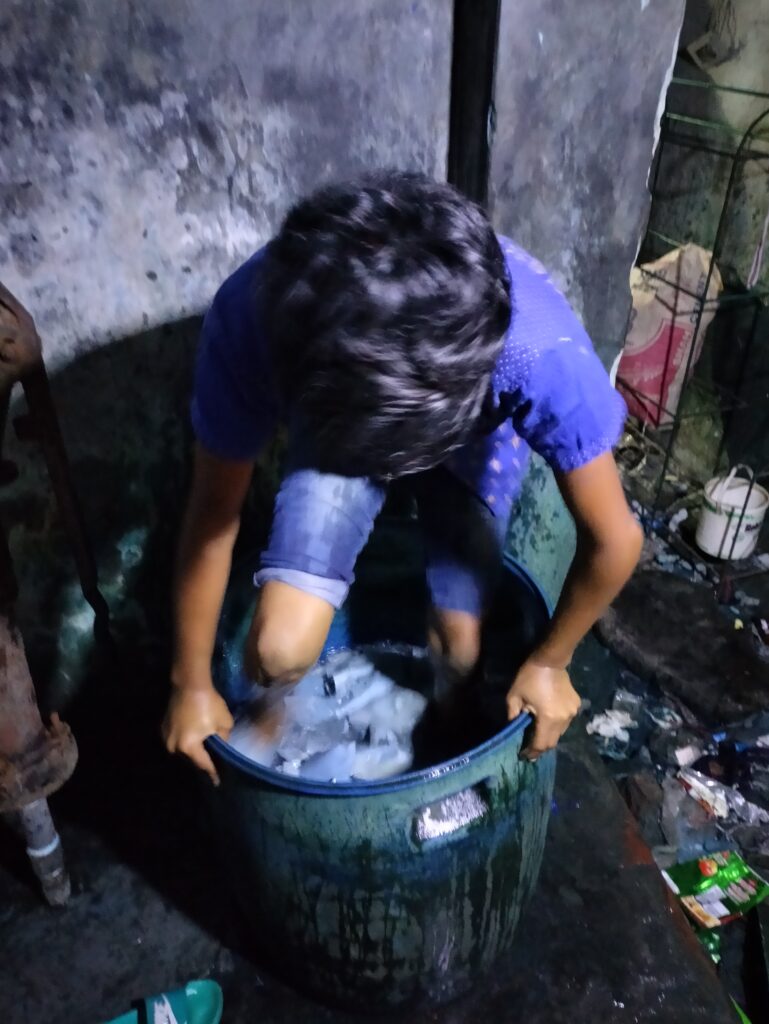Production-based wages and child apprentices
The realities of work in a shoe-making business in Bhairab.
Introducing Akther and his shoe making business
Akther owns the business ‘RD Shoes’, which operates from a small business unit, or factory, located in Taan Krishnanagar village, in the Bhairab division of Dhaka.
The business unit comprises three rooms, including a storeroom for the finished product. Machinery comprises an industrial sewing machine, three spray machines, an electric motor for finishing rubber soles and various other shoe making tools and instruments. There is also a TV set that Akther has arranged for his workers, so they can have some recreation in their leisure time.
Akther sells to six local buyers. Usually, the buyers contract Akther to produce a specific design of shoe but sometimes they select one of his designs. After some bargaining to fix a price a quantity of shoes is commissioned, and a deadline is set. Akther then ascertains the number of employees he needs and then undertakes the commission.
Akther employs eight to ten people on a regular basis, all of whom live in Taan Krishnanagar, like himself, or the neighbouring village of Jamalpur. During the busy season before Eid, when most of the large orders from buyers come in, he hires additional workers.
Three child apprentices (‘shagrids’) work at RD shoes, under the shagrid-ostad system which is commonplace in Bhairab. In exchange for free or very cheap labour the child learns from a mentor, or ‘ostad’. By mentoring the child, the ostad can increase their production output. In this case, the children live in the same village as Akther and are the children and grandchildren of his adult workers.
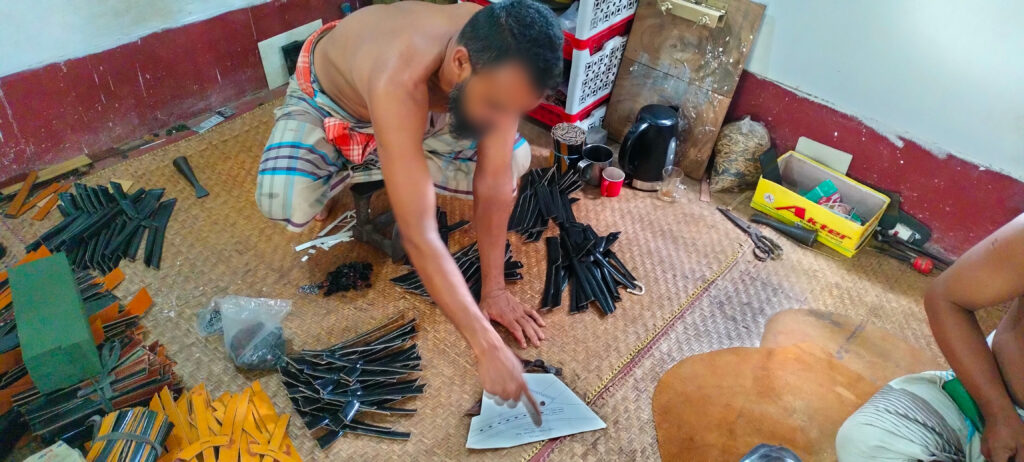
The business owner is cutting different parts of shoes according to the design
The work shadowing process
In April 2022, CLARISSA researchers accompanied Akther and twelve workers for four consecutive days to observe how his shoes are made.
It was peak season for shoe production, in the lead up to the Eid Festival (that ends Ramadan). More orders are placed at this time than at any other time of the year, so this was an opportunity to see the enterprise in operation at its busiest time.
Akther had lots of initial questions about the shadowing process, and the team explained that the purpose was to accompany him and the other workers to observe the business’s day-to-day processes for research purposes and that it would not impede the business in any way. Over the four days, CLARISSA researchers became acquainted with how each worker performed their tasks and they also received some of their reflections on their work. They learned a lot about what workers were paid and how the shagrid-ostad apprenticeship system works. At the end of each day the researchers recorded their observations and specific conversations in notebooks.
What happened at the shoe factory
Day one
On arriving at the premises on the first day, researchers observed that twelve workers were already assigned to their work, including three children. Akther explained that he had hired three more workers because of the volume of work during the Ramadan period.
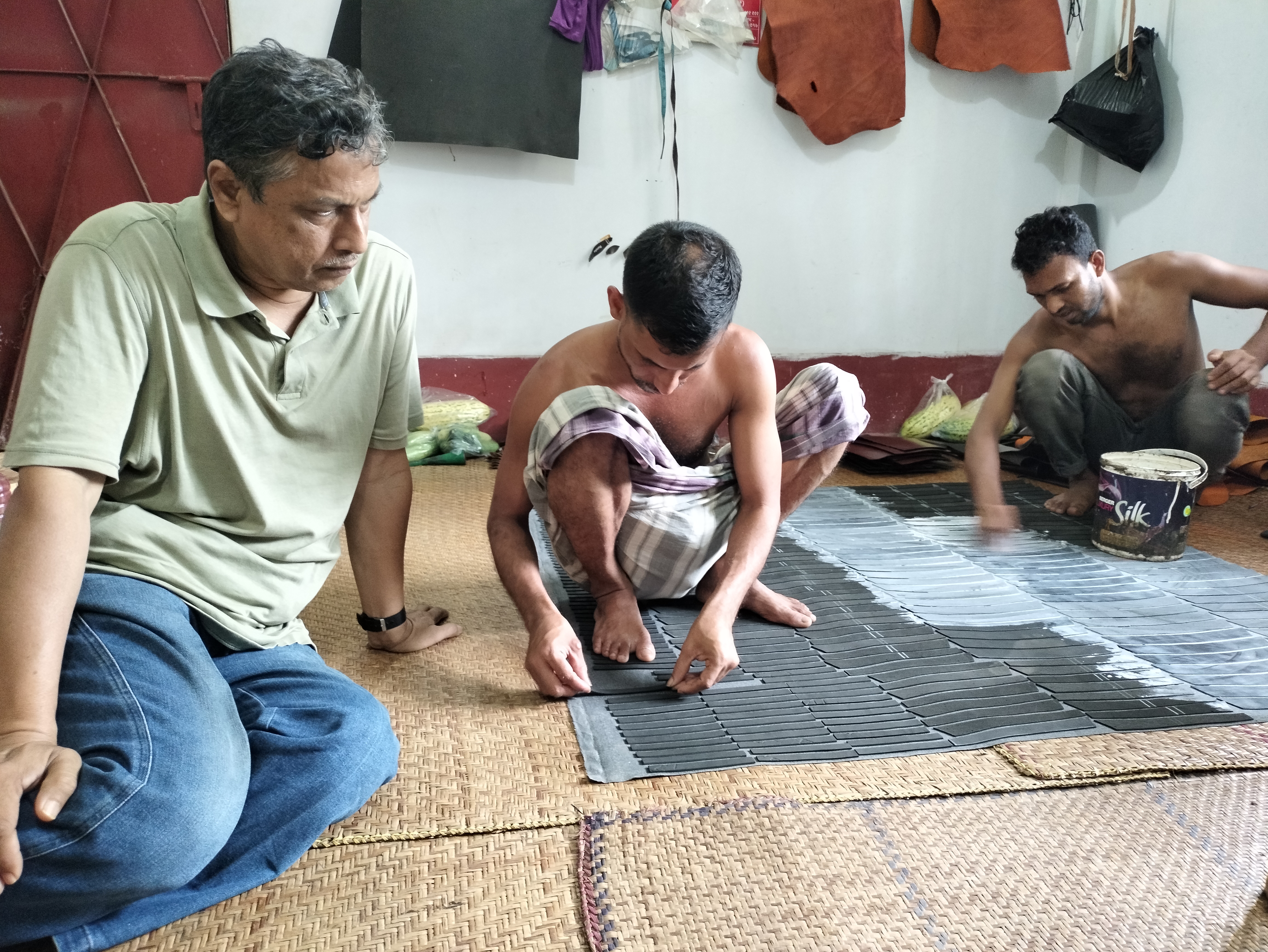
The factory is well equipped, and the researchers were struck by Akther’s skill at shoemaking. He worked fixing buttons and on decorative elements of the design on the upper part of the shoe. It was clear that the other workers had specific roles. One adult worker was making soles using a finishing machine, one was sewing the upper part of a shoe using a sewing machine, one was attaching leather to artificial leather, foam and rexine, and another was gluing and fitting shoes.
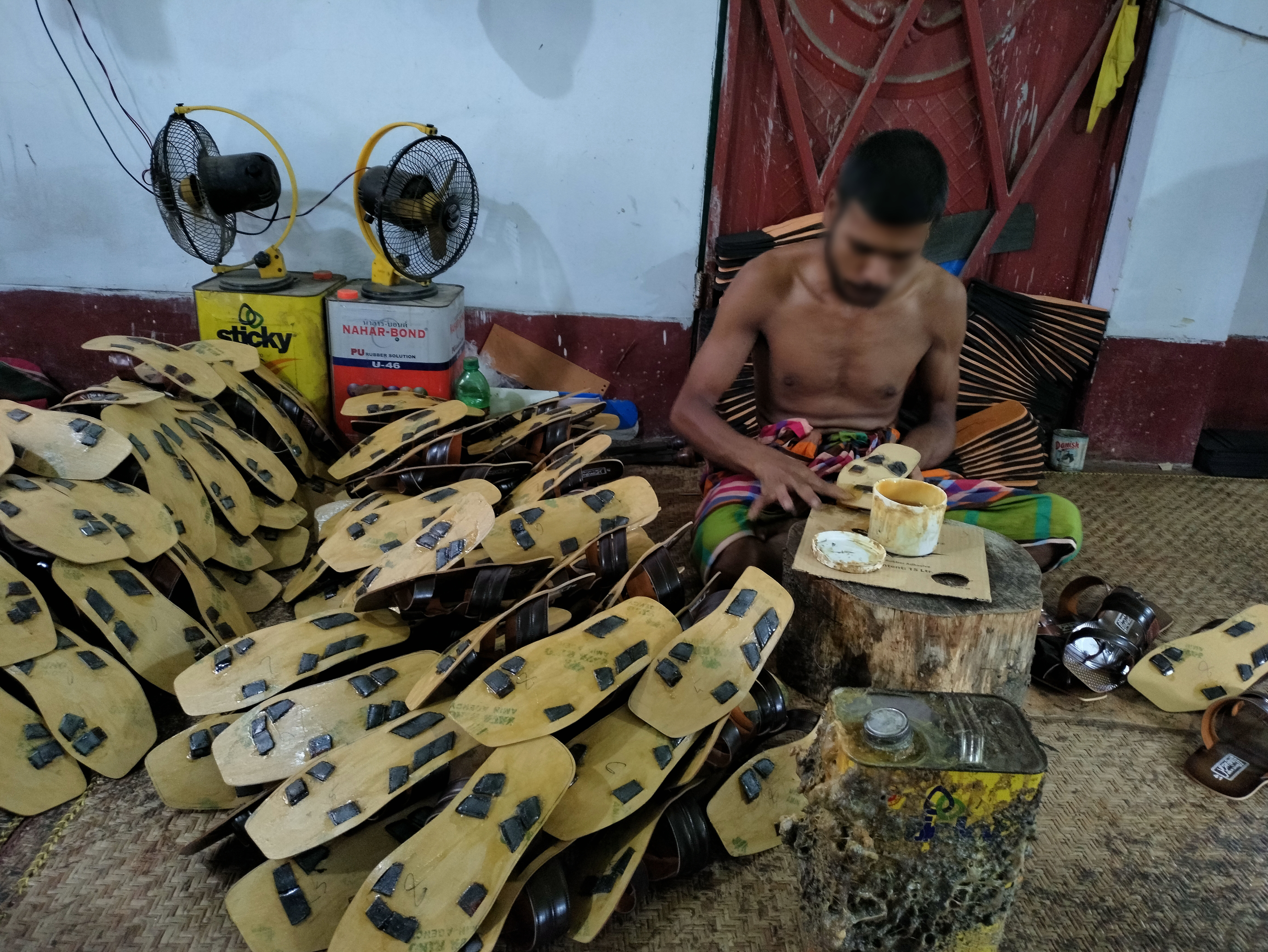
Abdur, with 16 years shoe making experience in the centre of Dhaka, was working on the upper part of shoes. Abdur’s grandson was working with him as an apprentice (shagrid). Nadim is 14 years old and works 12-hour days – sometimes until midnight. As well as working on the shoes the research team observed Nadim performing general tasks for Abdur including buying him tea and cigarettes and fetching his lunch.
Akther’s son was transporting the finished product and collecting raw materials from the local market.
Day 2
The day started at 10am and the researchers focused on learning how the soles of shoes are made. Israt, in his 30s, worked alone drawing lines on rubber soles, using a finishing machine and connecting heels with adhesive. Nazir, also in his 30s, worked alone as a sewing operator and fixing leather to foam and other materials to make the upper part of the shoe. Hamid, in his 40s, worked on some design elements and on fixing parts of the shoe together.
Day 3
The day started at 10 am again. A lot of the focus of workers was on making the upper parts of the shoes. An adult worked with a latex solution without any precautions for handling the solution, such as wearing gloves. There was a very strong smell.
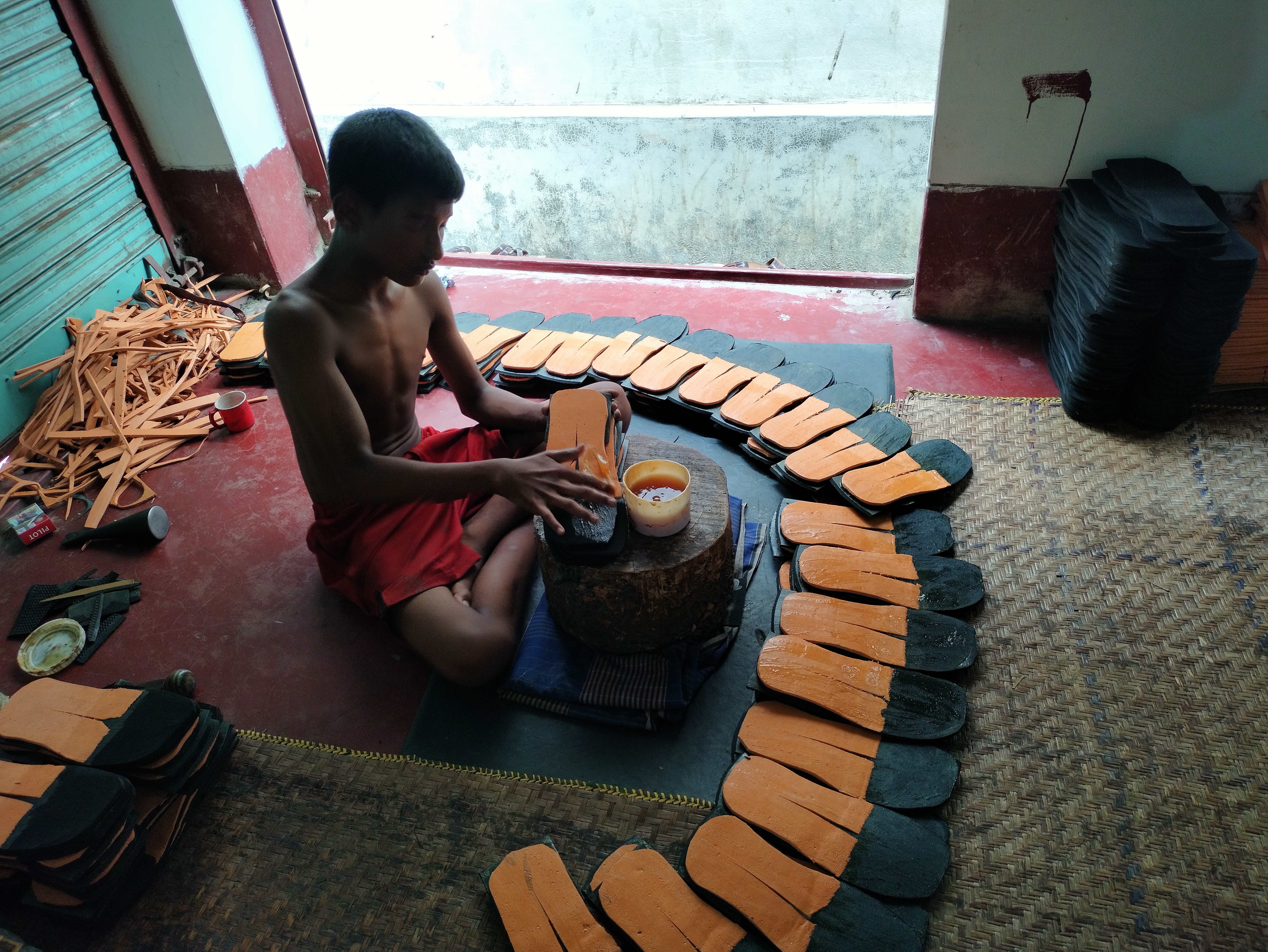
Sadiq, in his 40s, had his 11-year-old son working with him. Over the previous days, Sadiq had been reluctant to talk with the research team but on this day, he opened up a little, once his son had moved to another part of the factory. He explained that his initial reluctance to talk was related to the closure of another factory because of the presence of children. But once the researchers had become accepted, and gained his trust, he shared his perspective more freely saying:
I want my son to continue his studies. But during the pandemic the school closed. And he also does not want to go to school anymore That’s why, I have engaged him in my work. Here, he does not get any salary, he helps with my work and as a shagrid, he learns how to do leather work. After completing his learning, he will work independently. I can earn 200 BDT (US £1.80) for making one dozen pairs of shoes.
The research team observed that Sadiq was constantly putting pressure on his son. He assigned him a high quantity of work to complete within short time frames. He scolded him to increase his pace and hit him when his work was delayed.
Day 4
Everyone was busy with their individual work assignments, spaced out in the factory so all the activities of each worker were visible.
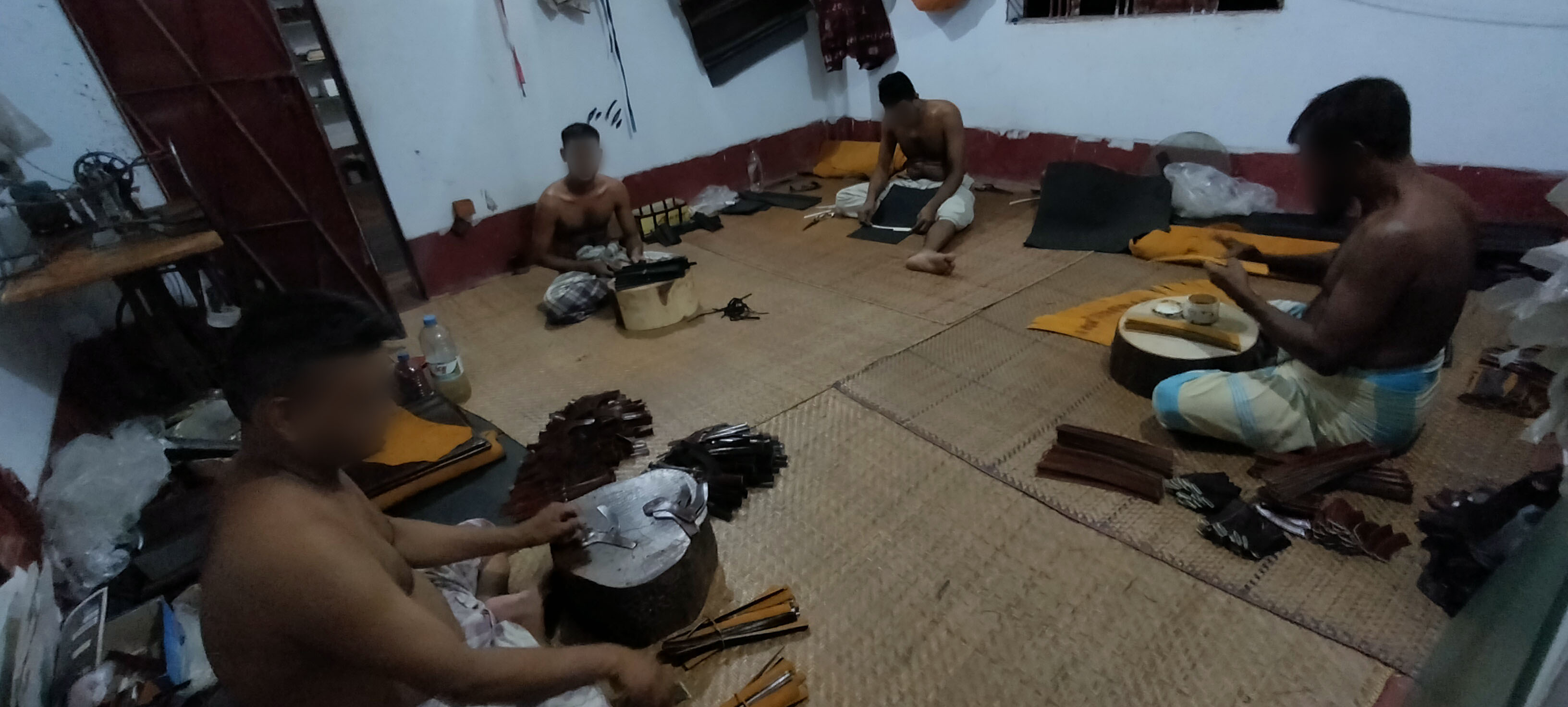
The most notable thing about this day was the team’s attempt to speak with Sadiq’s son about his experience at work. Habibur did not want to talk about his work or his experiences with the research team, including how long he had been working there. The team sensed that Habibur felt very uncomfortable.
Low production-based wages
All adult workers are paid on a production basis and their wages are very low. The most experienced shoemaker (after the owner) earns BDT 100-140 (US $0.90-1.25) for making the upper part of 12 pairs of shoes. For the cheaper wage he can make 20 dozen pairs a day. For the more complex designs, he gets paid more but he only makes 10-15 dozen pairs a day. This puts his earnings at approximately US $18 a day.
Dobir has worked attaching leather to artificial leather, foam and rexine for the last 15 years. He earns BDT 200 (US $1.80) per dozen shoes. Hamid works on the upper part of the shoes, and he also fits shoes and does some design and gluing. He earns up to BDT 100 per dozen and can produce 12 dozen per day, making his daily earnings US $10.
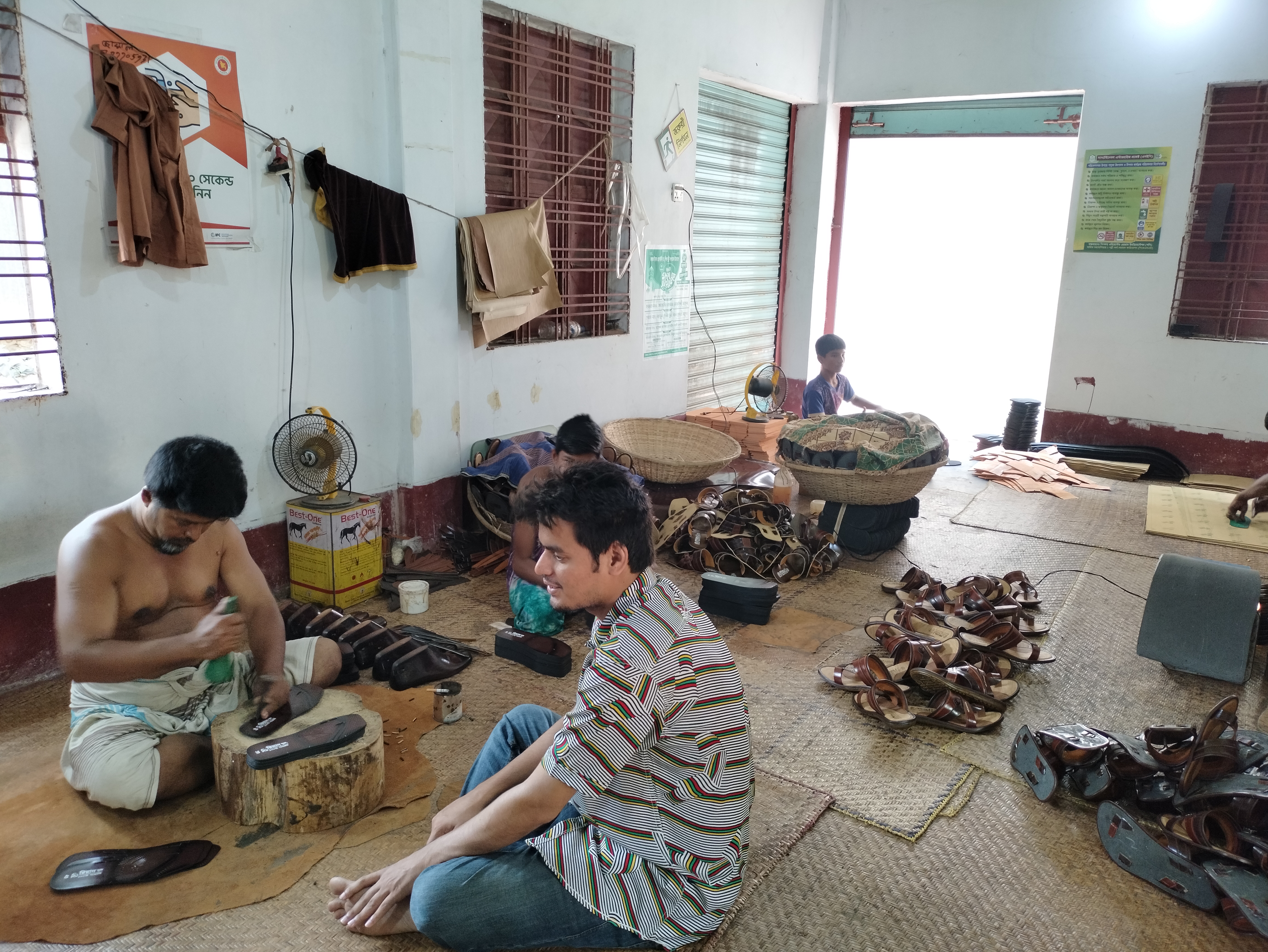
Working for production-based wages means that the workers have limited security of income. These wages reflect the best they will get all year, because they earn highest during peak season when order levels are high. Israt usually prepares 6 dozen soles a day and earns up to BDT 200 (US $1.82) per dozen. When we visited, he was earning BDT 1,098 (US $10) a day, but he explained that his workload and hours fluctuate throughout the year. The sewing operator, Nur, earns up to BDT 200 per dozen and produces three to four dozen per day during Eid or other peak seasons. A day wage of BDT 768 (US $7) is the best he can hope for over the course of the year.
The seasonal fluctuation in work is evened out with an informal credit system, whereby business owners lend workers money. This indebtedness of workers to business owners becomes a barrier to individuals choosing a different line of work. In conversation with CLARISSA researchers, one worker reported that:
“Most of the workers who work in this area want to quit this job. But, as they have taken loans from their employers during the off seasons, they have to continue this type of work and cannot leave this job until they pay off the loan”.
It seems difficult to conceive of how loans will be paid off under current wages.
Children working as apprentices
The two child employees work long hours for little money. The 14-year-old worker began work with his grandfather during the COVID-19 pandemic when schools closed. His father works overseas, and his mother is a housewife. He worked for seven months without any pay and now earns BDT 1,976 (US $18) a month. This is the same as what his grandfather (and mentor) earns in a day. The child frequently works 12 hours a day, sometimes until midnight.
The 11-year-old worker does not earn anything for his labour. He was instructed to work by his father when schools closed in the COVID-19 pandemic. His father mentors the boy so he can eventually earn independently. With his son’s help he can increase his productive output earning BDT 200 (US $1.80) for every 12 pairs of shoes he makes. The 11-year-old experiences a lot of work pressure and scolding and beatings from his father, which was freely carried out in the presence of the CLARISSA researchers. The implication is that verbal and physical abuse of children at work – especially when the abuser and abused belong to the same family – is normalised.
Health hazards
Shoe making at Akther’s production unit involves the use of adhesives and latex. The adult who worked directly with these solutions told researchers that when he first started, he sometimes became sick due to the intense smell, but later became used to it. He stated:
“All the workers who come and start this type of work must face this type of trouble first and gradually they become accustomed with this environmental hazard’’.
Typically, safety precautions are required for handling latex rubber including the use of gloves, eye protection, and respirators. Usage should take place in a well-ventilated room.
Conclusion
Akther runs a well-established and organised shoe production factory. He is a skilled shoe-maker. He recruits most of his workers from his own village and a village nearby. Employees have distinct roles in this business with the more skilled workers receiving higher wages than younger or lower skilled workers. All are paid production-based wages, so what they earn is determined by what they can produce, which in turn is determined by the size of commissions.
Children comprise 25% of Akther’s regular workforce. They work as apprentices or ‘shagrids’. The 14-year-old child works 12 hours a day and the 11-year-old is repeatedly put under verbal pressure and physically abused for missing deadlines. They are not paid as adults are for the work they do. School closures during the COVID-19 pandemic were causally linked to the children’s entry into the workplace.
The work carried out by Akther’s employees is intensified during the peak season leading up to Eid, when many more orders are placed for shoes. Such seasonality of work is linked to informal credit relationships between employer and employee that can restrict employees ability to choose other work. With wages as low as they are, it feels optimistic to expect workers will pay off their debts and be free to choose a different line of work.



